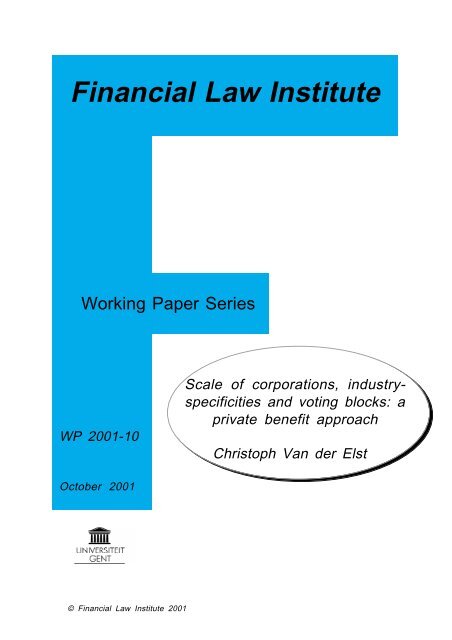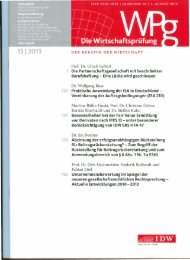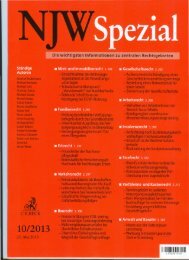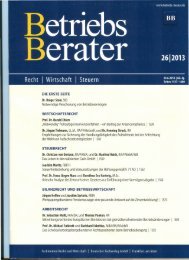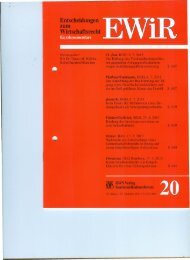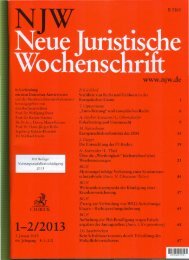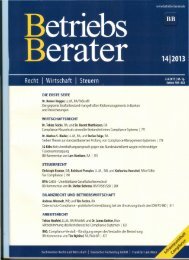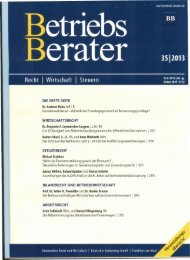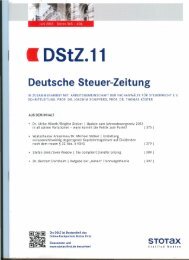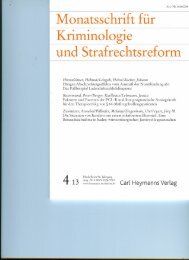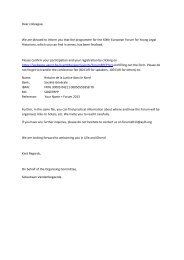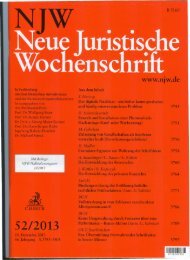Download - Universiteit Gent
Download - Universiteit Gent
Download - Universiteit Gent
You also want an ePaper? Increase the reach of your titles
YUMPU automatically turns print PDFs into web optimized ePapers that Google loves.
Financial Law Institute<br />
Working Paper Series<br />
WP 2001-10<br />
October 2001<br />
© Financial Law Institute 2001<br />
Scale of corporations, industryspecificities<br />
and voting blocks: a<br />
private benefit approach<br />
Christoph Van der Elst
The Financial Law Institute is a research and teaching<br />
unit within the Law School of Ghent University, Belgium. The<br />
research activities undertaken within the Institute focus on<br />
various issues of company and financial law, including<br />
private and public law of banking, capital markets<br />
regulation, company law and corporate governance.<br />
The Working Paper Series, launched in 1999, aims at<br />
promoting the dissemination of the research results of<br />
different researchers within the Financial Law Institute to<br />
the broader academic community. The use and further<br />
distribution of the Working Papers is allowed for scientific<br />
purposes only. Working papers are published in their original<br />
language (Dutch, French, English or German) and are<br />
provisional.<br />
For more information and a full list of available working<br />
papers, please consult the homepage of the Financial Law<br />
Institute at:<br />
© Financial Law Institute 2001<br />
http://www.law.rug.ac.be/fli<br />
© Financial Law Institute, <strong>Universiteit</strong> <strong>Gent</strong>, 2001
Scale of corporations, industryspecificities<br />
and voting blocks: a<br />
private benefit approach<br />
© Financial Law Institute 2001<br />
Christoph Van der Elst<br />
Abstract<br />
The major shareholdings directive (88/627/EEC) enables a detailed analysis of the<br />
stake and the identity of the largest shareholders of European stock listed corporations.<br />
However, in continental Europe only a limited number of studies provide an empirical analysis<br />
of the ownership and control of corporations.<br />
This study updates the data of the ECGN reports by analysing voting blocks of listed<br />
corporations in six European countries.<br />
Second, 1999 was the year Europe introduced the euro. The new database therefore<br />
allows to test on an European comparative level whether Demsetz and LehnÕs theory (1985)<br />
that larger corporations have a more dispersed ownership structure stands up to scrutiny.<br />
Third, BebchukÕs rent-seeking theory (1999) of the evolution of ownership and control<br />
will be partly tested. The private benefits of control for a given corporation depends not only<br />
on the legal rules as proven by La Porta et al. (1997) but also on company-specific and<br />
industry-specific parameters. If the theory of industry-specific private benefits stands up to<br />
scrutiny, a one way analysis of variance indicates significant differences between the means of<br />
the voting block of the largest shareholder for industry grouped companies. The results only<br />
partially confirm the influence of industry-specific characteristics. In different countries,<br />
different industries are characterised by different shareholder concentration patterns.<br />
Comments to the Author:<br />
christoph.vanderelst@rug.ac.be<br />
© Financial Law Institute, <strong>Universiteit</strong> <strong>Gent</strong>, 2001
Scale of corporations, industry-specificities and voting blocks: a private benefit<br />
approach<br />
I. Introduction<br />
Christoph Van der Elst<br />
Financial Law Institute<br />
Ghent University, Belgium<br />
The Directive on the information to be published when a major holding in a listed<br />
company is acquired or disposed of or the major shareholdings directive (88/627/EEC)<br />
enables a detailed analysis of the stake and the identity of the largest shareholders of<br />
European stock listed corporations. In fact article 4 of the Directive states that Òwhere<br />
a natural person or legal entity É acquires or disposes of a holdingÉ and where,<br />
following that acquisition or disposal, the proportion of voting rights held by that<br />
person or legal entity reaches, exceeds or falls below one of the thresholds of 10%,<br />
20%, 1/3, 50% and 2/3, he shall notify the company and at the same time the<br />
competent authority. É member States need not apply:<br />
- the thresholds of 20% and 1/3 where they apply a single threshold of 25%,<br />
- the threshold of 2/3 where they apply the threshold of 75%.Ó<br />
The Directive is strict as to the attribution of voting rights. The natural person or legal<br />
entity must determine the total number of voting rights held by other persons on<br />
behalf of the former, by an undertaking controlled by that person or entity, by a third<br />
party with whom that person or entity has concluded a written agreement which<br />
obliges them to adopt a common policy towards the management of that company,<br />
É 1<br />
The European council stated that this policy of adequate information of investors is<br />
likely to improve investor protection and to increase investorsÕ confidence.<br />
This Directive urges voting blocks of 10% or larger to be disclosed. In most European<br />
countries, and all countries in this paper, the legislator implemented lower thresholds.<br />
In Belgium, France, Germany and Spain shareholders acquiring a stake of 5% or more<br />
must disclose this stake; in the U.K. the first treshold is 3% and in Italy it is 2%.<br />
Since the implementation of this Directive in the different EU-states it is possible to<br />
undertake a more precise analysis of concentration of ownership and control of<br />
corporations.<br />
The European Corporate Governance Network studied in several European countries<br />
the disclosed data. 2 They found that within Europe, the level of concentration of<br />
1 See article 7 of the Directive. For a comment on the Directive see V. Edwards (1998).<br />
2 For an overview of the different reports, see Becht, M., 2000, Corporate Control in Europe,<br />
paper presented at the European Corporate Governance Forum, Brussels, 16 th November 2000,<br />
33 p.<br />
© Financial Law Institute 2001 1
voting power is not uniform. It seems that the differences are rooted in differences in<br />
customs and the legal environment in different countries. In the U.K. the median<br />
voting blok is less than 10% while in Germany, Austria and Italy it exceeds 50%.<br />
Further, voting power concentration is inversely related to size. Smaller companies<br />
tend to have larger shareholders.<br />
Before this European study was presented and published in working papers, Berglšf<br />
(1997) already found some prove in data of the OECD of a high level concentration of<br />
ownership stakes in different continental European countries. Franks and Mayer<br />
(1997) observed that in more than 80% of the largest companies listed on stock<br />
markets in France and Germany, one shareholder owns more than 25% of the shares.<br />
In more than 50% of the companies there is one majority shareholder. In the U.K. the<br />
number of controlled corporations is much lower. There data stem from 1990.<br />
La Porta, Lopez-de-Silanes and Shleifer (1999) looked at the ownership structures of<br />
the 20 largest and 10 medium sized companies in 27 rich economies and found that the<br />
number of widely held companies Ð id est without a single shareholder holding more<br />
than 20% of the voting rights Ð is limited, especially in countries with low<br />
ÒantidirectorÓ rights 3 .<br />
Faccio and Lang (2000) analyse the ownership and control of 3740 companies in five<br />
European countries. Using a 20% cut-off ratio, 38.1% of the companies are widely<br />
held. In the UK this figure is 68%, in Germany only 10%. More than 43% of all listed<br />
companies are controlled (at the 20% cut-off level) by families. This figure soars to<br />
65% in France and Germany but is only 20% in the U.K. A disadvantage of this<br />
detailed analysis is the use of a 10% and a 20% cut-off level. For instance, in<br />
Germany, an important cut-off level would be 25% - the blocking minority Ð not the<br />
20% level used in the study of Faccio and Lang.<br />
Some, mostly American scholars have developed theoretical models to explain the<br />
major differences in ownership structures.<br />
Demsetz and Lehn (1985) demonstrated that in the mid eighties ownership patterns<br />
depend on company size, the riskiness of the firm, regulation of firms and some sector<br />
activities like sports and media. For some European countries, Van der Elst (2001)<br />
confirmed that concentration is inversely related to company size but found mixed<br />
results for the other independent variables.<br />
La Porta, Lopez-de-Silanes, Shleifer and Vishny (1997) and La Porta, Lopez-de-<br />
Silanes and Shleifer (1999) argue that ownership structures and concentration patterns<br />
3 Antidirector rights are defined as an index aggregating the shareholder rights. The index is<br />
formed by adding 1 when (1) the country allows shareholders to mail their proxy vote to the<br />
firm, (2) shareholders are not required to deposit their shares prior to the general shareholdersÕ<br />
meeting, (3) cumulative voting or proportional representation of minorities in the board of<br />
directors is allowed, (4) an oppressed minorities mechanism is in place, (5) the minimum<br />
percentage of share capital that entitles a shareholder to call for an extraordinary shareholdersÕ<br />
meeting is less than or equal to 10 percent (the sample median), or (6) shareholders have<br />
premptive rights that can be waved only by a shareholdersÕ vote. The index ranges from zero<br />
to six.<br />
© Financial Law Institute 2001 2
of publicly listed companies are determined by legal differences and the strength of<br />
investor protection rights. In countries with relatively poor legal protection of<br />
investors, large blockholders are likely to occur more often.<br />
Roe develops a political model to explain ownership structures. In social democracies<br />
publicly listed companies are more likely to have a concentrated ownership. In those<br />
countries the government is forcing companies to stabilise employment and social<br />
welfare in general, rather than to allow companies to maximise profits for one<br />
particular class, id est the shareholders of the corporation. Further mechanisms to<br />
align the interest managers and shareholders, like option schemes and disclosure and<br />
accountability, are harder to implement in European social democracies. This policy<br />
creates higher agency costs and minimising those costs will be guaranteed by large<br />
shareholders having sufficient power to supervise managers effectively and efficiently.<br />
The findings of La Porta and al. are theoretically studied by Bebchuk (1999). In a<br />
theoretical model he found that controlled corporations should be expected to be more<br />
common in countries in which private benefits of control are large and vice versa. In<br />
those countries a founder is unlikely to relinquish control after an IPO or a capital<br />
increase. Notwithstanding the fact that countries differ greatly in their incidences of<br />
controlled corporations and corporations with a dispersed ownership structure, in<br />
most countries some companies of each type can be found. Therefore, Bebchuk<br />
argues, even in countries with a high level of investor protection rights some<br />
shareholders will gain private benefits out of control because there are companyspecific<br />
and industry-specific parameters. These parameters could be driven by<br />
opportunities to engage in self-dealing transactions, to take corporate opportunities or<br />
to profit from non-pecuniary benefits.<br />
These studies indicate nicely that the general corporate governance literature examining<br />
the implications of large blockholders in supplying superior monitoring and limitating<br />
private rent seeking (Burkart et al. 1997) must be shaded.<br />
This study built on those previous studies. If the theory of industry-specific private<br />
benefits stands up to scrutiny, a one way analysis of variance indicates significant<br />
differences between the means of the voting block of the largest shareholder for<br />
industry grouped companies. The results only partially confirm the influence of<br />
industry-specific characteristics. Further, as these industry-specific classes are<br />
generated for five countries, a cross-tabulation of two variables, countries and<br />
industry-activity indicate whether the protection of minority shareholders pressures<br />
for a different model of corporate governance. In different countries, different<br />
industries are characterised by different shareholder concentration patterns. Therefore<br />
legal rules that limit private benefits of control should be differentiated along company<br />
specific ownership structures.<br />
Section II describes the data construction. Section III briefly sketches the<br />
methodology of this study. Section IV presents the results. Section V concludes.<br />
© Financial Law Institute 2001 3
II Data construction<br />
1. Data sources<br />
This paper is based on a new database of ownership structures of listed companies in<br />
six European countries. Data on corporate ownership are still hard to resemble,<br />
therefore only a limited number of countries are in the database. In Belgium, Italy and<br />
Spain all data are officially disclosed by the stock exchange or a supervisory authority.<br />
The available data give a regularly or immediately updated overview of the disclosed<br />
stakes in a particular company. For Belgium and Italy even (some) information on the<br />
piramidal control chain is published. In France, Euronext Paris published the<br />
acquisition or disposals of the proportion of voting and capital rights of a major<br />
shareholder when it reaches, exceeds or falls below one of the thresholds but an<br />
overview of all the stakes of all major shareholders in a particular company lacks.<br />
Therefore, only if the annual report of the company deliberately discloses information<br />
on all major shareholder stakes, a detailed analysis of the ownership of the company is<br />
possible. In Germany, the Bundesaufsichtsamt fŸr den Wertpapierhandel updates<br />
every 15 days the blockholders of corporations traded in the official market segments.<br />
As each corporation in a piramidal structure reports its direct and indirect stakes,<br />
Hoppenstadt AktienfŸhrer was used to refine the disclosed data and enlarge the<br />
German database with companies listed in other market segments. For the U.K.,<br />
Hemscott published all owners with at least 3 percent of the voting rights, as well as<br />
directorsÕ ownership for all U.K. listed companies. A limited number of British<br />
companies have multiple classes of shares. In those cases the voting blocks of the<br />
major shareholders could not always be determined. Those companies are excluded<br />
from the database. Companies for which the largest shareholder is a nominee are also<br />
excluded. Table 1 reports the data sources for all six countries.<br />
The data are collected at the end of 1999. Hemscott permanently updates their<br />
ownership database. For British companies the data are collected at the end of April<br />
2001.<br />
Table 1: Data sources<br />
Belgium disclosure of voting blocks in financial newspapers ÒFinancieel-Economische TijdÓ and ÒEcho de la<br />
BourseÓ and annual reports of listed companies<br />
France annual reports of listed companies; Database Bourse de Paris: http://www.bourse-deparis/fr/frnews7/fsg710.htm<br />
(ÒdŽclarations de franchissement de seuilÓ and Òconventions<br />
dÕactionnairesÓ)<br />
Germany Hoppenstedt AktienfŸhrer; Bundesaufsichtsamt fŸr den Wertpapierhandel - Datenbank fŸr<br />
bedeutenden Stimmrechtanteile: http://www.bawe.de/db_site.htm<br />
Italy Commissione Nazionale per le SocietaÕ e la Borsa database:<br />
http://www.consob.it/trasparenza_soc_quot/assprop/attuale/menu.htm<br />
Spain Database of the Comision Nacional del Mercado de Valores:<br />
http://www.cnmv.es/english/queries/reg_ofi_ent_emisoras/reg_ofi_ent_emi.htm<br />
U.K. Database of Hemscott<br />
© Financial Law Institute 2001 4
For Belgium it was possible to find the ownership data of all listed companies; for the<br />
other countries a large number of corporations are included in the sample. For France<br />
the database is focusing on the larger corporations. Table 2 reports the number of<br />
corporations included in the databases as well as their relative importance. For<br />
Belgium, Germany, Italy and Spain the majority of the listed corporations are<br />
analysed. 4 The database contains a large sample of French and British corporations.<br />
For all continental European countries the corporations stand for more than 80% of<br />
total market capitalisation. For the U.K., the first part of the study excludes<br />
investment companies. The other corporations are valued 45% of the market<br />
capitalisation of the London Stock Exchange.<br />
Table 2: Companies included in the database<br />
Belgium France Germany Italy Spain U.K.<br />
number of companies 140 160 542 234 209 619(820) 5<br />
% of all listed companies 100% 16.6% 52.0% 97.7% 81.3% 27.0%(35.8%<br />
)<br />
% of total market cap. 100% 83.8% 95.0% 98.0% 93.5% 45.5%<br />
For each individual company two parameters classify the corporations: size and<br />
industry specificity. Table 3 shows the number of companies in each size class. For<br />
the U.K. a conversion rate of 1 euro = 0.62 £ was used.<br />
Table 3: (Relative) number of companies classified by size<br />
Capitalisation Belgium Germany France Italy Spain U.K.<br />
large corp. >5 bill. 7 37 43 29 14 42<br />
medium corp. 1-5 bill. 21 69 29 44 24 51<br />
small corp. 0.25-1 bill. 27 119 19 62 50 112<br />
micro corp. 5 bill. 5.0% 6.8% 26.9% 12.4% 6.7% 6.8%<br />
medium corp. 1-5 bill. 15.0% 12.7% 18.1% 18.8% 11.5% 8.2%<br />
small corp. 0.25-1 bill. 19.3% 22.0% 11.9% 26.5% 23.4% 18.1%<br />
micro corp.
elatively frequent in the database. Due to some large privatisations, the number of<br />
large Italian corporations is relatively high compared to the number of large<br />
corporations in other countries. In the U.K. more than 2/3 of all corporations are<br />
microcaps. In the other countries microcaps count for 40% -Italy and France Ð to 60%<br />
- Belgium, Germany and Spain Ð of all listed corporations. The U.K. is the only<br />
country for which corporations with a market capitalisation of around 1 million euro<br />
is regularly found.<br />
Table 4: Sector activity and number of companies in the database<br />
Sector classification<br />
Nr. Belgium Germany Italy Spain U.K.<br />
Automobiles & parts 25 9<br />
Banks 1 6 21 37 17 10<br />
Beverages, Food producers &<br />
processors<br />
7 14 16 6 19 42<br />
Chemicals (U.K.) & pharmaceuticals 6<br />
3 8 28 8 6 19<br />
Construction & building materials 2 8 24 9 19 84<br />
Diversified industrials 23 8<br />
General retailers 21 20<br />
Electronic & electrical equipment 6 36 7 13 42<br />
Engineering & machinery 5 6 51 6 71<br />
Health 8 19 30<br />
Holding companies 12 23 31 17 15<br />
Household goods & textiles 9 6 31 36 12 61<br />
Insurance and Life Assurance 10 15 13 5 28<br />
Investment banks 11 19 14<br />
Investment companies 12 201<br />
Leisure, entertainment & Hotels 20 12<br />
Media & Photography 19 10 9<br />
Mining 27 11<br />
Oil & gas 13 35<br />
Other financial & speciality 11 19<br />
Personal care & household products 22 8<br />
Pharmaceuticals (U.K.) 14 29<br />
Real estate 15 17 17 16 30 89<br />
Software & computer services 4 8 73 34<br />
Steel 24 7<br />
Support services 18 54<br />
Telecommunication Services 16 13<br />
Transport 26 8 8<br />
Utilities 17 10 7 19<br />
This study uses also data on the sector activity of the company. To start, the FTSE<br />
global classification system was used. It determines economic groups, sectors and<br />
6 For the U.K. pharmaceuticals is studied as a different class.<br />
© Financial Law Institute 2001 6
subsectors. In this study, all corporations were classified at a sector level. 7 The<br />
classification was expanded for holding companies, which differ substantially from the<br />
British investment companies. If only stock listed companies are studied, these<br />
numbers illustrate that the general believe that the industrial landscape in European<br />
countries is a mix of manufacturing and services industries and cannot explain the<br />
dichotomy in capital markets, is not correct. Ownership concentration discrepancies<br />
could differ due to the specific industrial landscape of listed companies in different<br />
countries.<br />
2. Methodology<br />
First a descriptive analysis of the voting block of the largest shareholder is given. The<br />
average, median, standard deviation, maximum and minimum block of shareholders of<br />
corporations in six countries explain concentration patterns in the different European<br />
countries.<br />
Within each country the average and median voting block of the four size classes of<br />
corporations are calculated. At an industry specific level, the average and the median is<br />
compared.<br />
Second the empirical part analyses whether there are significant differences between<br />
the mean of the different groups of companies within and between countries. A one<br />
way anova is used to test if any differences exist among the means for the groups of<br />
corporations of different size and different industry-specificity within a country. The<br />
one-way anova tests hypotheses about differences between two or more population<br />
means.<br />
As far as the assumptions for an anova analysis concerns, the independence is<br />
guaranteed as any particular stake of a shareholder, size or industry-specificity of the<br />
corporation is independent of the ÒscoresÓ of all other subjects. However, the<br />
homogeneity of variances and normality assumptions might be violated. As anova is<br />
not sensitive to violations of the assumption of normality 8 , we focus on the<br />
assumption of homogeneity. If the Levene test indicates the violation of the<br />
assumption of homogeneity the logarithm of the absolute stake was used. Differences<br />
between countries are tested for size of the corporation and industry-specificity in a<br />
factorial analysis of variances. For this type of analysis the same assumptions as for<br />
an one way anova are applicable. In both models, land of incorporation/size class and<br />
land of incorporation/industry, the homogeneity is not guaranteed, even after<br />
implementing the logarithm of the stake. Therefore the results must be read with<br />
caution and are only tentative.<br />
7<br />
Except utilities at an industry level and for the U.K., investment banks at a subsector level. In<br />
all countries except the U.K., chemical and pharmaceuticals were grouped in one class due to<br />
the lack of detailed data.<br />
8<br />
Shavelson, R., (1988), Statistical reasoning for the behavioral sciences, Boston, Allyn and<br />
Bacon, p. 349.<br />
© Financial Law Institute 2001 7
III. Results<br />
1) Descriptive analysis<br />
a) Country analysis<br />
* Concentration of voting blocks<br />
There is a significant difference between the voting blocks of the largest shareholder in<br />
continental European countries and the UK. In the latter the largest shareholder has on<br />
average a voting block of 18.3%, while in the former countries the averages differ<br />
between 37.9% in Spain to 52% in France. In France and in Italy more than half of the<br />
corporations have one majority shareholder. For Belgium, where 50% of the<br />
corporations have one shareholder owning more than 40.9% of the voting rights, the<br />
number of controlled corporations is significantly higher. At least 20% of all<br />
corporations have shareholders acting in concert and controlling the company. 9 Due to<br />
the lack of data for the other European countries, these figures could not be presented<br />
in this table.<br />
A comparison between these data and the ultimate voting blocks of non-financial<br />
companies on an offical market in the mid Ô90ies (Becht, 2000) learn that in Italy,<br />
Germany, Belgium and Spain the median voting block diminished, while in France and<br />
the U.K. the median voting block soared. However in the latter countries the sample in<br />
the ECGN study is different of the one in this study.<br />
From this study one can deduct an evolution of Ònetwork-orientedÓ countries towards<br />
a more market-oriented approach, as far as ownership concentration is concerned.<br />
In Germany, Italy and Spain some corporations only issued non-voting stock. In these<br />
cases, some shareholders hold all the voting rights.<br />
Further, as Bebchuk (1999) already indicated, in each country some corporations have<br />
a widely distributed ownership structure, without shareholders holding more than 5%<br />
of the votes.<br />
Figure 1 gives detailed information of the distribution of the voting blocks of the<br />
largest shareholder in the different European countries. In continental European<br />
countries a significant number of corporations have one shareholder with more than<br />
75% of the voting rights. Only 2 corporations in the UK have this type of majority<br />
shareholder. In Germany and Belgium this block is important as it allows to change<br />
the articles of the corporation and therefore creates the possibility to extract private<br />
benefits. 10 Therefore it is not surprising to find the highest number of this kind of<br />
controlled corporations in Germany. However, it seems that the Belgian shareholders<br />
are relatively less interested in this kind of voting block. The figures for France, Italy<br />
9<br />
See Van der Elst (2001), Aandeelhouderschap van beurgenoteerde vennootschappen, <strong>Gent</strong>,<br />
Larcier, 2001, 397 p.<br />
10<br />
For example, the general meeting has to change the articles to issue stock options.<br />
© Financial Law Institute 2001 8
and Spain are less significant. In those countries, other thresholds must be reached to<br />
change the articles. For instance in France 2/3 of the votes is sufficient.<br />
Table 5: Concentration of the voting block of the largest shareholder (1999)<br />
Voting block of the largest<br />
shareholder<br />
Belgium France Germany Italy Spain U.K.<br />
average 41.71 51.98% 46.13% 48.14% 37.91% 18.26%<br />
st. dev. 21.72 25.55% 26.60% 22.20% 26.95% 13.51%<br />
median 40.94 54.94% 47.00% 51.53% 30.02% 14.15%<br />
maximum 88.99 99.66% 100% 100% 100% 78.12%<br />
minimum
Figure 1: Distribution of the voting blocks of the largest shareholder<br />
60%<br />
50%<br />
40%<br />
30%<br />
20%<br />
10%<br />
0%<br />
>75% 50-75% 25-50% 10-25%
* Size of listed companies and the largest shareholders<br />
The European Corporate Governance Network found that the size of the corporation<br />
influences the stake of the largest shareholder (Becht, 2000). Demsetz and Lehn<br />
(1985) proved this thesis for over 400 U.S. corporations. Table 6 and 7 give some<br />
detailed information on the average and median stake of the largest shareholder in four<br />
size classes. In all countries, the largest shareholder has on average the smallest voting<br />
block in large corporations. Nevertheless the average voting block of the largest<br />
shareholder substantially differs between different countries. Whereas large Italian<br />
corporations have a shareholder holding on average 40% of the votes 11 , a U.K.<br />
corporation of the same size only have a shareholder owning on average 7.6% of the<br />
ordinary voting shares.<br />
Table 6: Average voting block of the largest shareholder classified by size of the<br />
company<br />
Belgium 12 Germany France Italy Spain U.K.<br />
All companies 41.71% 46.13% 51.98% 48.14% 37.91% 18.26%<br />
Large 35.66% 30.13% 30.18% 40.30% 27.12% 7.65%<br />
Medium 36.23% 53.09% 49.27% 46.38% 39.00% 12.85%<br />
Small 44.21% 47.78% 59.86% 48.40% 47.56% 16.98%<br />
Micro 42.76% 45.86% 64.55% 51.07% 35.06% 21.50%<br />
Large shareholders of large corporations in Spain, France and Germany seem to have a<br />
comparable voting block. However, when comparing means one can see large<br />
differences in the variance of the voting blocks between these countries (table 7). Half<br />
of the largest blocks in the largest Spanish corporations do not exceed 11% where at<br />
least 50% of the largest shareholders of large German corporations hold a blocking<br />
minority stake of 25%.<br />
In all other size classes, the largest shareholder has a significantly larger voting block.<br />
The differences between continental European countries and the U.K. are large for<br />
each size type. Notwithstanding the fact that the average voting block of the largest<br />
shareholder of micro caps in the U.K. is three times as large as these of the largest<br />
U.K. caps, it remains significantly smaller than the largest block in continental<br />
European corporations. In French small and microcaps, medium German corporations<br />
and Italian microcaps the largest shareholder has, on average, a majority stake. 13 More<br />
than 50% of all French and Italian corporations, except the large caps, have one<br />
11<br />
When concerting shareholders are studied, the average in Belgium is even higher: 43.5%.<br />
12<br />
For concerting shareholders, the averages are: large companies: 43.5%; medium: 51.5%;<br />
small: 50.9%; micro: 53.2%.<br />
13<br />
Belgian concerting shareholders have an average voting block of more than 50% in medium,<br />
small and micro caps.<br />
© Financial Law Institute 2001 11
majority shareholder. 14 The same conclusion can be drawn for medium and small<br />
German corporations.<br />
Another difference between the largest shareholder of a U.K. company and the largest<br />
shareholder of continental European companies concerns the ratio between the<br />
averages and median values. In the U.K., in each size class, a small number of<br />
companies have one shareholder with a significantly higher voting block. These blocks<br />
significantly influence the average. Therefore the median voting block is lower than the<br />
average in the U.K.. In all other countries at least one size class have more than 50%<br />
of the companies with a shareholder owning a block that is higher than the average.<br />
Table 7: Median voting block of largest shareholder classified by size of the company<br />
Belgium 15 Germany France Italy Spain U.K.<br />
All companies 40.94% 47.00% 54.94% 51.53% 30.01% 14.15%<br />
Large 34.79% 25.00% 24.00% 37.82% 10.81% 5.29%<br />
Medium 33.28% 56.75% 50.42% 53.55% 35.99% 9.90%<br />
Small 42.97% 50.00% 57.87% 52.28% 49.26% 13.01%<br />
Micro 44.24% 45.08% 67.85% 51.14% 27.00% 16.66%<br />
* industry specificity<br />
Given the large differences of the voting blocks of the largest shareholder in the U.K.<br />
compared to those in continental European countries, it is not surprising that in each<br />
industry class the average voting block of the largest shareholder in a U.K. company is<br />
smaller than in the same industry class in other countries (table 8).<br />
In each country the differences between some of the industry classes are significant<br />
and except for Italy, the lowest average is less than half of the highest average.<br />
Furthermore, in all countries except in the U.K., in some industry classes the average<br />
shareholder controls the company, while in others, the largest shareholder has on<br />
average only an influential minority voting block. Third, no homogeneity in the<br />
averages of the voting blocks in one industry can be found. As an example, one can<br />
refer to the class of real estate corporations. In Belgium, the largest shareholder of<br />
these companies does not have, on average, a blocking minority of 25%. In Italy, real<br />
estates companies are, on average controlled by one shareholder holding more than<br />
60% of the votes.<br />
Some of the lowest and highest figures can be found in the financial sector. Banks have<br />
only small shareholders in the U.K. and, relatively speaking, in Italy, while the average<br />
block of the largest shareholder of other financial companies in Germany is more than<br />
10% below the other German industry averages. Furthermore, banks in the U.K. have<br />
on average a shareholder with a voting block that is less than half the percentage of all<br />
U.K. listed companies. However, it must be stated that most U.K. listed banks belong<br />
14<br />
The same conclusion is valid for Belgian companies when the voting blocks of the concerting<br />
shareholders are analysed.<br />
15<br />
For concerting shareholders the medians are: large companies: 40.0%; medium: 57.0%; small:<br />
55.2%; micro: 55.3%.<br />
© Financial Law Institute 2001 12
to the group of the large caps. High concentration patterns can be found in the<br />
insurance industry in Spain where it is the only industry class with shareholders<br />
having on average one majority shareholder. However, it must be said that only a<br />
limited number of Spanish corporations active in this industry are stock exchange<br />
listed. Nevertheless, one of the highest concentration levels for Germany is found in<br />
the industry class ÒinsuranceÓ.<br />
Another remarkable Òwithin industryÓ difference is located in the chemicals and<br />
pharmaceuticals industry. This is the only industry class where the average of the<br />
stake of the largest shareholder is below the threshold of 50% in all countries. 16<br />
Table 9 presents the median voting block for each sector in each country. An asterisk<br />
indicates the median blocks which differ more than 10% of the average voting block.<br />
Especially in Spain this exercise shows the remarkable differences between the mean<br />
and the median. In five industry classes the average is significantly influenced by a<br />
number of companies having one shareholder with a larger stake: Chemical & Pharma,<br />
Electronic & electrical equipment, Household goods and textiles, Real estate and<br />
Utilities.<br />
In Italy, Germany and Belgium, the industry class with the highest average is not the<br />
same as the class with the highest median. Engineering & Machinery in Belgium,<br />
Insurance in Germany and Beverages and Food in Italy are industry classes with<br />
higher medians than resp. Holding companies, Personal care and household products<br />
and Real estate corporations with the highest average.<br />
16 This is also the case for the sector Electronic and electrical equipment, but only four countries<br />
have a sufficient number of listed companies in that industry.<br />
© Financial Law Institute 2001 13
Table 8: Average voting block of the largest shareholder in different industry classes<br />
Sector classification<br />
Belgium Germany Italy Spain U.K.<br />
Automobiles & parts 45.3%<br />
Banks 35.7% 55.7% 36.1% 49.1% 6.7%<br />
Beverages, Food producers & processors 41.8% 50.5% 53.4% 36.7% 26.8%<br />
Chemicals & pharmaceuticals 42.6% 43.6% 41.3% 33.9% 13.6%<br />
Construction & building materials 37.5% 52.6% 50.7% 44.8% 17.1%<br />
Diversified industrials 36.4%<br />
General retailers 54.1%<br />
Electronic & electrical equipment 39.4% 45.3% 29.0% 19.5%<br />
Engineering & machinery 49.9% 51.9% 40.5% 16.2%<br />
Health 45.1% 17.0%<br />
Holding companies 52.9% 38.4% 38.2% 23.9%<br />
Household goods & textiles 48.2% 59.6% 50.3% 29.6% 23.5%<br />
Insurance and Life Assurance 60.7% 49.1% 55.2% 17.3%<br />
Investment banks 25.7% 18.2%<br />
Investment companies 16.0%<br />
Leisure, entertainment & Hotels 51.6%<br />
Media & Photography 42.6% 53.9%<br />
Mining 32.7%<br />
Oil & gas<br />
Other financial & speciality<br />
19.7%<br />
Personal care & household products 62.5%<br />
Pharmaceuticals 13.7%<br />
Real estate 24.3% 49.2% 60.2% 37.4% 23.5%<br />
Software & computer services 35.8% 36.2% 18.6%<br />
Steel 44.0%<br />
Support services 46.6%<br />
Telecommunication Services 15.8%<br />
Transport 46.0% 33.2%<br />
Utilities 50.6% 52.8% 22.7% 13.3%<br />
Finally from all these industry-specific information on concentration of ownership it<br />
is already clear that industry-specificity can only be one of more variables to explain<br />
the private benefits of control. In fact, the average and median concentration ratios<br />
show other patterns of ownership concentration ÒinÓ and ÒbetweenÓ countries.<br />
© Financial Law Institute 2001 14
Table 9: Median voting block of the largest shareholder in different industry classes<br />
Sector classification<br />
Belgium Germany Italy Spain U.K.<br />
Automobiles & parts 50.9%<br />
Banks 29.1% 56.8% 32.6% 40.5% 6.3%<br />
Beverages, Food producers & processors 35.9% 46.4% 58.1% 30.5% 19.1%<br />
Chemicals & pharma 43.4% 45.4% 42.2% 21.5% 11.0%<br />
Construction & building materials 39.0% 47.5% 52.5% 48.5% 13.4%<br />
Diversified industrials 24.1%<br />
General retailers 54.8%<br />
Electronic & electrical equipment 42.2% 51.0% 14.8% 13.2%<br />
Engineering & machinery 56.1% 55.7% 42.3% 14.2%<br />
Health 46.0% 14.2%<br />
Holding companies 55.2% 34.2% 41.9% 24.9%<br />
Household goods & textiles 55.9% 60.2% 52.1% 18.8% 17.2%<br />
Insurance and Life Assurance 62.9% 51.0% 56.6% 13.8%<br />
Investment banks 18.8% 16.5%<br />
Investment companies 12.6%<br />
Leisure, entertainment & Hotels 50.9%<br />
Media & Photography 34.2% 55.0%<br />
Mining 28.5%<br />
Oil & gas<br />
Other financial & speciality<br />
16.9%<br />
Personal care & household products 61.1%<br />
Pharmaceuticals 9.8%<br />
Real estate 15.0% 49.3% 54.5% 27.4% 18.6%<br />
Software & computer services 33.8% 29.4% 16.7%<br />
Steel 37.5%<br />
Support services 51.0%<br />
Telecommunication Services 14.5%<br />
Transport 53.6% 25.3%<br />
Utilities 49.0% 51.0% 10.5% 8.4%<br />
© Financial Law Institute 2001 15
2) Empirical analysis<br />
The first part of this section clearly indicated that there are some significant<br />
differences in ownership concentration. Not only in different size classes, the largest<br />
shareholder owns different voting blocks, but also in the different industry classes.<br />
Furthermore, it is already clear that even countries having the same legal ÒrootsÓ, like<br />
Spain, Italy and Belgium, do not share the same ownership structure. A one way<br />
analysis of variance indicates whether significant differences of ownership<br />
concentration exist for different size and industry classes within different countries.<br />
A factorial analysis of variance tests the same relationship between the different<br />
countries.<br />
All tables read from column to row.<br />
a) Analysis within countries<br />
Within countries it is analysed whether size or industry significantly influences the<br />
ownership concentration structure of listed corporations.<br />
* Size specificity<br />
A one-way anova shows that ownership structures in countries differ as far as size is<br />
used as an explanatory factor. Table 10 indicates that size is not always a<br />
discriminatory variable to explain differences in ownership concentration.<br />
For Germany the general model shows significant differences. These differences stem<br />
from the smaller stake of the largest shareholder in large caps. The average stake is<br />
between 15% and 23% smaller in large corporations than in the other classes. Between<br />
other classes the differences are not significant.<br />
Large Spanish corporations have a significantly wider distribution of ownership than<br />
small corporations. On average the stake is 21% larger in small corporations than in<br />
large corporations. Somewhat surprising, but it could already be deducted from table 6<br />
and 7, the average voting block of Spanish micro caps is significantly smaller than the<br />
average voting block of small corporations.<br />
The figures for the U.K. cannot be compared with the other countries. The Levene<br />
test indicates that the hypothesis of the homogeneity of the variances must be<br />
rejected. Therefore the logarithm of the stakes of the largest shareholder was taken. All<br />
the results are significant and the hypothesis that larger companies have a more widely<br />
distributed ownership structure is confirmed.<br />
For Belgium and Italy no significant ownership concentration differences exist<br />
between the different classes of groups of companies.<br />
From these data one can conclude that the thesis that larger corporations have a more<br />
widely distributed ownership structure must be shaded. For some countries no<br />
© Financial Law Institute 2001 16
significant differences can be found, while for some size classes the inverse scenario is<br />
true.<br />
Table 10: One way anova for voting blocks and size of corporations<br />
F Large comp. Medium Small<br />
Belgium 0.809<br />
Large<br />
Medium 0.58%<br />
Small 8.56% 7.98%<br />
Micro 7.11% 6.53% 1.45%<br />
Germany 6.292***<br />
Large<br />
Medium 23.00%*<br />
Small 17.17%* -5.83%<br />
Micro 15.72%* -7.28% -1.45%<br />
Italy 1.775<br />
Large<br />
Medium 6.09%<br />
Small 8.10% 2.01%<br />
Micro 10.77% 4.68% 2.67%<br />
Spain 3.823**<br />
Large<br />
Medium 11.89%<br />
Small 20.96%* 9.08%<br />
Micro 7.74% -4.14% -13.22%*<br />
U.K. (Logstake) 34.21***<br />
Large<br />
Medium 0.155*<br />
Small 0.291* 0.136*<br />
Micro 0.391* 0.236* 0.101*<br />
*: significant at 5%-level; ** significant at 2%-level; ***: significant at 1%-level.<br />
* Sector specificity<br />
The Belgian model for industry-specificity is significant at the 2% level. However the<br />
number of significant individual relationships between different industries is rather<br />
low. Holding companies (nr.12) have significant larger shareholders than real estate<br />
corporations (15). The difference between these two classes is more than 28%. Real<br />
estate corporations have a relatively wider distribution of ownership.<br />
© Financial Law Institute 2001 17
Table 11: One way anova for voting blocks and industry-specificity of corporations in<br />
Belgium<br />
Belgium industry 1 2 3 4 5 7 9 12<br />
F: 2.623**<br />
industry<br />
1<br />
2 -1.8<br />
3 -7.0 -5.2<br />
4 -0.1 1.7 6.9<br />
5 -14.3 -12.5 -7.3 -14.2<br />
7 -6.1 -4.3 0.9 -6.0 8.2<br />
9 -12.6 -10.8 -5.6 -12.5 1.7 -6.5<br />
12 -17.2 -15.4 -10.3 -17.1 -2.9 -11.1 -4.7<br />
15 11.3 13.1 18.3 11.4 25.6 17.4 23.9 -28.5*<br />
The numbers in the rows and columns of the table stand for specific industries and are described in table<br />
4.<br />
*: significant at 5%-level; **significant at 2%-level;<br />
The German model is significant at the 1%-level. However, as for Belgium the number<br />
of industry classes with significant higher or lower concentration levels is limited.<br />
ÒOther financial servicesÓ(nr. 11) is the only class for which the industry average is<br />
significantly smaller than the average of several other industry classes. Banks (1),<br />
engineering & machinery (5), household goods & textiles (9) and insurance companies<br />
(10) have a significantly larger shareholder. The difference of Òother financialsÓ with<br />
the industry Òengineering & machineryÓ is 26%, with ÒbanksÓ 30.1%, with<br />
Òhousehold goods and textilesÓ 33.9% and with the Òinsurance companiesÓ 35%.<br />
Second the computer industry (4) has a significantly wider distribution of ownership<br />
stakes than the sector household goods & textiles. This difference is more than 23%.<br />
All the other differences are not significant at the 5%-level.<br />
© Financial Law Institute 2001 18
Table 12: One way anova for voting blocks and industry-specificity of corporations in<br />
Germany<br />
Germany<br />
F: 2.871***<br />
1 2 3 4 5 6 7 8 9 10 11 12 15 17 18 19 20 21 22 23<br />
1<br />
2 3.1<br />
3 12.1 9.0<br />
4 19.5 16.5 7.5<br />
5 3.8 0.7 -8.3 -15.7<br />
6 16.3 13.2 4.2 -3.3 12.5<br />
7 5.2 2.2 -6.8 -14.3 1.4 -11.0<br />
8 10.6 7.5 -1.5 -9.0 6.8 -5.7 5.3<br />
9 -3.9 -6.9 15.9 -23.4* -7.7 -20.1 -9.1 -14.4<br />
10 -5.0 -8.0 -17.0 -24.5 -8.8 -21.2 -10.2 -15.5 -1.1<br />
11 30.1* 27.0 -18 10.5 26.2* 13.8 24.8 19.5 33.9* 35.0*<br />
12 17.3 14.2 5.2 -2.2 13.5 1.0 12.0 6.7 21.2 22.3 -12.8<br />
15 6.5 3.5 -5.6 -13.0 2.7 -9.7 1.3 -4.0 10.4 11.5 -23.5 -10.8<br />
17 5.1 2.0 -6.9 -14.5 1.3 -11.2 -0.2 -5.5 9.0 10.0 -25.0 -12.2 -1.4<br />
18 9.1 6.0 -3.0 -10.4 5.3 -7.2 3.9 -1.4 13.0 14.1 -20.9 -8.2 2.6 4.0<br />
19 13.1 10.1 1.1 -6.4 9.3 -3.1 7.9 2.6 17.0 18.1 -16.9 -4.1 6.6 8.1 4.0<br />
20 4.1 1.0 -8.0 -15.4 0.3 -12.2 -1.1 -6.5 8.0 9.1 -25.9 -13.2 -2.4 -1.0 -5.0 -9.0<br />
21 1.6 -1.4 -10.5 -17.9 -2.2 -14.6 -3.6 -8.9 5.5 6.6 -28.4 -15.7 -4.9 -3.5 -7.5 -11.5 -2.5<br />
22 -6.8 -9.8 -18.6 -26.3 -10.6 -23.0 -12.0 -17.3 -2.9 -1.8 -36.8 -24.1 -13.3 -11.9 -15.9 -19.9 -10.9 -8.4<br />
23 19.3 16.3 7.3 -0.2 15.5 3.1 14.1 8.8 23.2 24.3 -10.7 2.0 12.8 14.3 10.2 6.2 15.2 17.7 26.1<br />
24 11.7 8.7 -0.3 -7.8 7.9 -4.5 6.5 1.2 15.6 16.7 -18.3 -5.6 5.2 6.7 2.6 -1.4 7.6 10.1 18.5 -7.6<br />
The numbers in the rows and columns of the table stand for specific industries and are described in table<br />
4.<br />
*: significant at 5%-level; ***significant at 1%-level;<br />
In the United Kingdom more differences of the average voting block between different<br />
industries are significant. However as for the size of the corporation, the Levene test<br />
indicated that the homogeneity of variances must be rejected. Therefore the logarithm<br />
of the stakes was used as the dependent variable.<br />
Banks (nr. 1), Food producers & beverages (7) and Household goods and textiles (9)<br />
are all industry classes for which the largest shareholder has a significant different<br />
voting block compared to the voting block of the largest shareholder of more than two<br />
other industry-classes.<br />
The average stake of the largest shareholder in Banks (1) is significantly smaller than<br />
the stakes of shareholders in corporations active in the production of Food &<br />
beverages (7), Household goods and textiles (9), or Real estate corporations (15).<br />
The concentration of voting blocks within the industries Food & beverages (7) or<br />
Household goods and textiles (15) is significantly higher than the concentration in the<br />
industry class Investment companies (12), Pharmaceuticals (14) and Utilities (17).<br />
The two latter industries have a significantly wider distribution of ownership than<br />
Real estate corporations (15).<br />
© Financial Law Institute 2001 19
Finally, Real estate corporations (15) are more concentrated, as far as the ownership<br />
structure is concerned than companies in the Utilities sector (17).<br />
Table 13: One way anova for voting blocks and industry-specificity of corporations in<br />
U.K.<br />
U.K.<br />
F: 4.625***<br />
1 2 3 4 5 6 7 8 9 10 11 12 13 14 15 16 17<br />
1<br />
2 -0.29<br />
3 -0.22 0.08<br />
4 -0.35 -0.06 -0.14<br />
5 -0.29 -0.006 -0.08 0.07<br />
6 -0.33 -0.04 -0.12 0.02 -0.04<br />
7 -0.47* -0.18 -0.25 -0.12 -0.18 -0.14<br />
8 -0.27 -0.02 -0.06 0.08 -0.01 0.06 0.19<br />
9 -0.42* -0.13 -0.21 -0.08 -0.14 -0.09 0.05 -0.15<br />
10 -0.31 -0.02 -0.09 0.04 -0.02 0.02 0.16 -0.04 0.11<br />
11 -0.35 -0.06 -0.14 0.00 -0.65 -0.02 0.12 -0.08 0.07 -0.04<br />
12 -0.28 -0.01 -0.06 0.07 -0.007 -0.05 0.19* -0.006 0.14* 0.03 0.07<br />
13 -0.32 0.03 -0.11 0.03 -0.03 -0.01 0.15 -0.05 0.10 -0.01 0.03 -0.04<br />
14 -0.19 0.11 0.03 0.17 0.10 0.15 0.28* -0.09 0.24* 0.12 0.17 0.10 0.14<br />
15 -0.42* -0.13 -0.20 -0.07 0.13 -0.09 0.05 -0.15 0.004 -0.11 -0.07 -0.14* -0.10 -0.24*<br />
16 -0.28 0.01 -0.06 -0.07 -0.009 0.05 0.19 -0.004 0.14 0.03 0.07 0.002 0.04 -0.09 0.14<br />
17 -0.12 0.17 -0.09 0.23 0.17 0.21 0.35* 0.15 0.30* 0.19 0.23 0.16 0.20 0.06 0.30* 0.16<br />
The numbers in the rows and columns of the table stand for specific industries and are described in table<br />
4.<br />
*: significant at 5%-level; ***significant at 1%-level;<br />
No results are given for Italy and Spain as the test for the homogeneity of variances is<br />
not guaranteed even after the transformation of the voting block. Furthermore, the<br />
general results indicate no significant differences.<br />
© Financial Law Institute 2001 20
) Analysis between countries<br />
A factorial analysis of variance can explain to what extent the place of incorporation<br />
and the size or the industry-specificity determine the size of the voting block of the<br />
largest shareholder.<br />
For both general models, the assumption of homogeneity was violated. Even the<br />
transformation of the voting block by the logarithm of the block does not prevent the<br />
violation. Therefore the results should be carefully interpreted.<br />
* Size specificity<br />
The size of the corporation and the country of incorporation both have their impact<br />
on the voting block of the largest shareholder. Given the data found in the descriptive<br />
analysis, it seems that only in combination with a certain legal system, the largest<br />
corporations will have significantly smaller shareholders.<br />
Furthermore, as the significance for the independent variable Òcountry of originÓ is<br />
much higher than the significance for the size of the corporations, one can deduct that<br />
the legal system or the new interest group theory 17 is of more importance for the<br />
dispersion of ownership than the size of the corporation.<br />
Table 14: factorial analysis of variance Ð factors: size class and country of<br />
incorporation<br />
Source of variation sum of squares df mean square F Sig.<br />
Size 3.226 3 1.075 12.934 0.000<br />
Land 41.786 4 10.447 125.633 0.000<br />
Size*Land 4.275 12 0.355 4.267 0.000<br />
Error 130.897 1574 0.009<br />
* Industry specificity<br />
Preliminary, it must be mentioned that for all countries only six sectors have a<br />
sufficient number of corporations to test the variances in a factorial variance analysis.<br />
These sectors are: banks, food producers and processors, chemicals and<br />
pharmaceuticals, construction and building materials, household goods and textiles and<br />
real estate corporations.<br />
The results for the model country of origin and industry-specificity differ from those<br />
for the model land / size class. In the descriptive analysis we already found significant<br />
industry-specific differences between countries. The factorial analysis proves that the<br />
sector specificity is important for the dispersion of ownership in combination with the<br />
country of incorporation. There are some indications that the independent variable<br />
17 Cf. infra.<br />
© Financial Law Institute 2001 21
industry-specificity influences the dispersion of ownership but the significance of the<br />
result is rather low.<br />
Table 15: factorial analysis of variance Ð factors: industry-specificity and country of<br />
incorporation<br />
Source of variation sum of squares df mean square F Sig.<br />
Sector 0.947 5 0.189 2.107 0.063<br />
Land 20.565 4 5.141 57.16 0.000<br />
Sector*Land 4.358 20 0.218 2.423 0.001<br />
Error 62.871 699 0.009<br />
V. Policy conclusions and further research<br />
Recently a number of theories on the development of capital markets and ownership<br />
structures emerged. While La Porta et al. (1997) focus on the protection of minority<br />
shareholders as a driver for the development of capital markets and dispersed<br />
ownership, Roe (2000) points at the major impact of social democracies. Bebchuk<br />
(1999) believes the ownership structure is not only determined by the legal origin of a<br />
country but also by industry-specific and company-specific parameters. These<br />
parameters determine the private benefits the shareholder(s) extract from a<br />
corporation. This study refines these two parameters. Ownership concentration<br />
differs substantially between countries. Within countries some industries have<br />
substantially larger shareholders than others. However, only for a limited number of<br />
industries these differences are statistically significant. Furthermore the differences<br />
within a country are different between countries. Industry-specificities seem only to<br />
be important in combination with the country of incorporation. This indicates that the<br />
legal system is of more importance for the dispersion of ownership than industryspecificity.<br />
Further, as differences are found between different sectors in different countries,<br />
company specific characteristics determine the opportunities for majority<br />
shareholders to extract private benefits rather than industry characteristics.<br />
As Italy, Spain and Belgium have the same legal roots, the civil law origin (La Porta et<br />
al., 1997), and their concentration patterns differ from one another, these findings<br />
support the recent interest group theory of financial development (Rajan and Zingales<br />
2001) rather than the countryÕs legal origin theory. In Belgium, a significant number of<br />
corporations in different industries have families as controlling shareholders. Direct<br />
voting blocks are held by intermediary holding companies (pyramids), controlled by<br />
these mostly noble families. The holding companies were founded in the 1930Õs due to<br />
new specific financial legislation. These laws prohibited banks to participate in<br />
industrial companies. Some studies indicate that these controlling blocks constrain the<br />
development of small and medium sized Belgian companies (Van Hulle, 1998). It<br />
certainly could help to explain the severe regression of the ratio of deposits to GDP,<br />
the fraction of gross fixed capital formation raised via equity and stock market<br />
© Financial Law Institute 2001 22
capitalization over GDP after the 1930Õs (see table 1, 2 and 3 in Rajan and Zingales,<br />
2001).<br />
The Italian scenery of shareholders of listed companies is comparable to the Belgian<br />
situation. A limited number of families control a large number of listed corporations.<br />
However, the openness of the country was smaller and the direct government<br />
intervention larger. This enables the Italian government the speeding up the<br />
development of the financial system, already encouraged by the Draghi reform. Until<br />
recently, the political constellation of Spain significantly differed from that in Belgium<br />
and Italy. It probably had an impact on the different financial development and<br />
ownership structures of companies. This can be the subject of further research.<br />
Finally one can argue that measures to enhance a dispersed ownership structure<br />
should focus on the company specific parameters to extract private benefits. These<br />
measures must be embedded in an environment with structural impediments for the<br />
domestic incumbents to retard financial developments.<br />
© Financial Law Institute 2001 23
References<br />
Bebchuk, L., 1999, A Rent-Protection Theory of Corporate Ownership and Control,<br />
Cambridge, NBER Working paper 7203, 39 p.<br />
Becht, M., 2000, Corporate Control in Europe, paper presented at the European<br />
Corporate Governance Forum, Brussels, 16 th November 2000, 33 p.<br />
Berglšf, 1996, ÒCorporate GovernanceÓ, in European Equity Markets, B. Steil (ed.),<br />
London, Royal Institute of International Affairs, 147-148.<br />
Burkart, M., D. Gromb and F. Panunzi, 1997, ÒLarge shareholders, monitoring and<br />
fiduciary dutyÓ, Quarterly Journal of Economics, 693-728.<br />
Demsetz, H. and K. Lehn, 1985, ÒThe structure of corporate ownership: causes and<br />
consequencesÓ, Journal of Political Economy, 1155-1177.<br />
Edwards, V., 1998, ÒThe Major Shareholdings DirectiveÓ, The Company Lawyer, 104-<br />
110.<br />
Faccio, M. and L. Lang, 2000, The Separation of Ownership and Control Ð An analysis of<br />
ultimate ownership in Western European corporations, working paper, Universita<br />
Cattolica del Sacro Cuore and Chinese University of Hong Kong, 54 p.<br />
Franks, J. and C. Mayer, 1997, ÒCorporate Ownership in the U.K., Germany and<br />
FranceÓ, in Studies in International Corporate Finance and Governance Systems, D.<br />
Chew (ed.), Oxford, Oxford University press, 281-296.<br />
La Porta, R., F. Lopez-de-Silanes, A. Shleifer and R. Vishny, 1997, Legal Determinants of<br />
External Finance, Journal of Finance, 1131-1150.<br />
La Porta, F. Lopez-de-Silanes and A. Shleifer, 1999, Corporate Ownership around the<br />
World, Journal of Finance, 471-517.<br />
Rajan, R. and L. Zingales, 2001, The Great Reversals: The Politics of Financial<br />
Development in the 20 th Century, University of Chicago, working paper nr. 526, 62 p.<br />
Roe, M., 2000, Political preconditions to separating ownership from corporate control,<br />
working paper, Columbia University, 67 p.<br />
Shavelson, R., 1988, Statistical reasoning for the behavioral sciences, Boston, Allyn and<br />
Bacon, 744 p.<br />
Thompson, S., 2000, Ownership Structure and Economic performance in thelargest<br />
European Companies, paper presented at the European Corporate Governance Forum,<br />
Brussels, 16 th November 2000, 44 p.<br />
Van der Elst, C., 2001, Aandeelhouderschap van beursgenoteerde vennootschappen,<br />
<strong>Gent</strong>, Larcier, 397 p.<br />
Van Hulle, C., 1998, ÒIs het systeem van corporate governance belangrijk? Op zoek naar<br />
de impact van verschillen in modellenÓ, in Informatie en kennis in de economie, R. De<br />
Bondt and R. Veugelers (eds.), leuven, Universitaire pers, 287-333.<br />
© Financial Law Institute 2001 24


